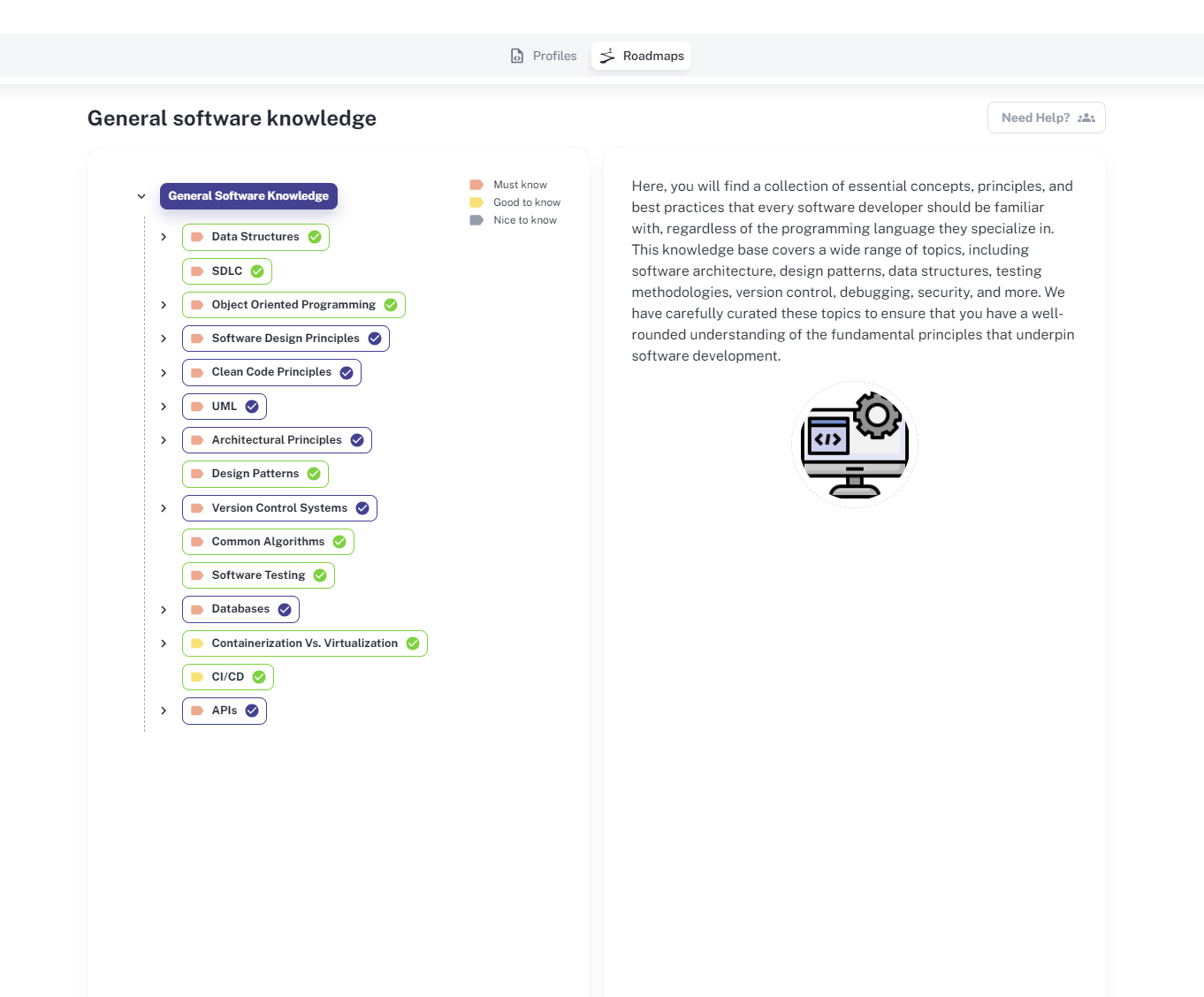How we revolutionized learning for our developers: Enlight Knowledge Maps
.jpg)
Imagine a world where innovation never stagnates, collaboration flourishes, and knowledge flows freely — sounds incredible, right? Anyone familiar with knowledge management and its challenges can attest to just how crucial (and difficult) achieving this truly is.
But why is that?
In today's fast-paced and rapidly evolving tech industry, the ability to effectively manage knowledge has become a critical factor for success, and all companies — from startups to established tech giants — benefit from effectively managing what their teams know. So how come even Fortune 500 companies lose roughly $31.5 billion a year by failing to share knowledge?
The answer is simple: managing knowledge within a company is difficult and requires dedicating organizational resources to ensure it is done properly.
Firstly, the rapid pace of technological advancements and evolving industry trends make it difficult to organize and disseminate knowledge effectively. Information becomes outdated quickly, rendering previous knowledge obsolete.
Secondly, the sheer volume of data generated within tech companies can be overwhelming, making it challenging to identify relevant and valuable knowledge amidst the noise. Knowledge is often decentralized, dispersed across teams and individuals, which can hinder accessibility and collaboration.
This is why we’ve taken on a strategic approach to knowledge management: by creating the role of Chief Knowledge Officer and developing Knowledge Maps, our own app for knowledge management, we are overcoming these obstacles and effectively capturing, organizing, and sharing the expertise and experiences of our teams.
Knowledge management is important to us for several reasons:
- We want to fuel innovation by providing a foundation on which new ideas and solutions can be built and foster a culture that drives continuous improvement, ensuring we learn from every project and pass that knowledge forward.
- We value collaboration within teams and across departments. When employees have easy access to relevant information and insights, they can collaborate more efficiently, make better-informed decisions, and deliver high-quality results.
- In tech, data and information are abundant, but things are always changing. We need to filter and organize this data, then transform it into actionable knowledge. By providing teams with accurate and up-to-date information, we empower them to utilize their knowledge effectively.
An essential part of our knowledge management strategy is an app we’ve named Knowledge Maps. We spoke to Chief Knowledge Officer Boris Šijan about how this app is changing the way our developers learn.
Q: Let’s start at the beginning: What are Knowledge Maps?
Knowledge Maps is an interactive app we use within Enlight to manage and share knowledge, create personal development plans, and track the progress and development of each person.
A few years ago, we defined different developer profiles. These are combinations of roles and skills. For each of those profiles we specified what knowledge, skills and tools a developer needs to have and know in order to be able to do their job as best as possible.
Knowledge Maps is essentially what we use to give each employee a tailored development plan. Based on their current knowledge, skills and needs of the projects they’re assigned on, the knowledge maps tell them what their development road is - which topics they still need to master.
Additionally, it gives them all the resources needed to acquire that knowledge - online courses, materials or contact with other colleagues in the companies who are experts in the area they are yet to master.
We want them to have a clear path to their development, one that isn’t burdened with unknowns and wasted time.
We use Topics within the app to segment different theoretical knowledge, but we also have different practical tasks for each profile. This is a way for people to apply what they’ve learned.
A different section of the Knowledge Maps app is Useful Guides. This is a type of technical blog where we can share best practices — people can write about how they did something or specific problems they’ve encountered in their work.
Q: Why develop an app for knowledge management?
Our goal has always been to have qualified engineers who can create and deliver high quality software product. To be able to provide high quality service and create high quality products, knowledge management is crucial. Especially in the IT industry where trends and technology is rapidly evolving and changing.
We wanted everyone to have a personal development plan so they can clearly see what the next step in their learning journey is and how they will be growing within the company.
Through the app, team leads have access to their team member’s knowledge maps which helps with tracking people’s growth.
Q: How does it work in practice?
When first signing in, people choose their developer’s profile, which were predefined based on company’s strategy, projects’ needs and market trends.
Based on that, they receive a visual presentation of all the topics relevant to that profile.

The app allows them to access other profiles as well — the chosen profile is always at the forefront, but everyone can see Roadmaps of other profiles.
The way we present them is akin to learning paths, by outlining relevant topics and different subtopics that branch out and provide deeper understanding.
Each topic has subtopics and materials engineers can use for learning. They can see which colleagues they can contact for support or in person knowledge sharing.
Learning can happen continuously.
Q: What did knowledge management at Enlight look like before? How did Knowledge Maps come to be?
We used to have a document listing everything we think different developer profiles need to know. It wasn’t structured and organized like it is now and it was much harder to track individual progress. The first step to a better knowledge management system was properly defining all profiles and figuring out what each profile needs to learn.
A team of our colleagues here at Enlight developed the app. It was a good experience for them because they were both users of the app and its creator, so they could suggest and implement their own ideas.
We’ve implemented learning paths, a standard way of presenting what needs to be done visually. Other functionalities, like being able to track progress and team lead access, came out of our needs.
It was my responsibility to provide a framework, but everyone can build on it with useful resources. These profiles need to be kept up to date — technology changes quickly, and what’s in use today can be old news by tomorrow.
Our engineers can leave comments on them or suggest different materials that we could include in the app, so we are constantly evolving it.
Q: How has Knowledge Maps changed working at Enlight?
It’s saved time for our engineers — they no longer have to spend ages searching for learning materials or “how to” tutorials when everything is in the app. They also know exactly what they need to learn based on their profile. This leads to highly skilled and motivated engineers.
Making development plans is now simple and easy, since the very way we present things tells you exactly what you need to do next at every stage in your growth journey. Team leaders can now track individual development.
Another benefit of Knowledge Maps is the ability to easily share knowledge - to know exactly who to contact about any given topic, and ask them to talk or help you with something. Another possibility is working on practical problems and solutions, documenting and sharing them with other people and teams.
In addition to that, we can now use Useful Guides as a way of documenting and retaining knowledge within the company. It gives us the ability to have an internal technical blog.
Knowledge Maps has changed the way we learn and work at Enlight
Effective knowledge management is the lifeblood of tech companies, fueling innovation, collaboration, and individual growth. Knowledge Maps stands as a testament to Enlight’s commitment to fostering a culture of continuous learning and knowledge sharing. By empowering developers with personalized access to resources and facilitating connections with experienced colleagues, this app helps our company make sure each project is a learning opportunity.
Subscribe to our newsletter
Stay informed about the nearshoring and software engineering trends shaping the future of your industry.




.jpg)






